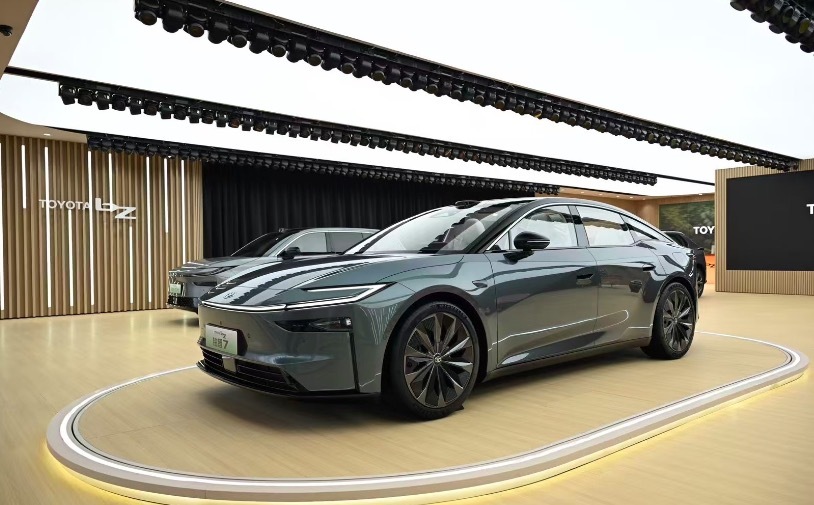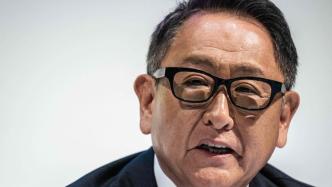
"Automotive News" recently celebrated its centenary. This old media outlet, which has witnessed the global automotive industry's century-long ups and downs, reserved the coverage of the commemorative special issue for Toyota Motor Chairman Akio Toyoda, an industry innovator standing at the node of fourth-generation family inheritance.
100 years ago, it was also an important opportunity for the Toyota family to enter the automotive industry.

When the historical coordinates of the two giants in their respective industries intersected in 1925, this dialogue across the Pacific not only unveiled Toyota's century-long journey from automatic looms to global automotive hegemony, but also outlined a new chapter of "inheritance and evolution" for this veteran automaker at the crossroads of the electrification wave and the intelligent revolution.
In 1925, the G-type automatic loom invented by Akio Toyoda's great-grandfather Sakichi Toyoda went into mass production. This revolutionary device, which could automatically change the shuttle without stopping the machine, increased the efficiency of textile production several times and accumulated the first pot of gold for Toyota's transformation into the automobile industry. Even more dramatic is that Shoichiro Toyoda, the father of Akio Toyoda and the man who would witness the rise of Toyota Motors in the future, was born at this time.
"1925 was the first year that the rules of the game changed." Automotive News used the family history created by Sakichi Toyoda as the opening of a centennial special issue. In the report, Akio Toyoda stood in front of a replica of a loom in his Tokyo office, his fingertips gently stroking the grain of the cast iron frame.
When the Ford Model T rolled off the assembly line at a rate of one every 24 seconds in 1925, the Toyota family had not yet set foot in automobile manufacturing. However, it was the financial reserves brought by the G-type loom that allowed Toyoda Sakichi's son, and Toyoda Akio's grandfather, Kiichiro Toyoda, to set up the Automobile Department in 1933 and Toyota Motor Industries in 1937. Then, it was the long road for Toyota to become the world's number one.
When the era of internal combustion engines came to an end and the era of new energy arrived, and global automakers rushed to the pure electric route, Akio Toyoda showed extraordinary strategic determination. "Our enemy is not the internal combustion engine, but carbon dioxide." He emphasized this concept many times in the interview. Data shows that Toyota has sold 27 million hybrid vehicles worldwide, and its cumulative carbon reduction is equivalent to the effect of 9 million pure electric vehicles. "But if we directly produce 9 million pure electric vehicles, it will generate carbon emissions," said Akio Toyoda.
Behind the data is Toyota's insistence on multiple technological paths: from the hybrid era opened by the Prius, to the technical reserves of the hydrogen fuel cell vehicle Mirai, to the research and development breakthroughs in all-solid-state batteries, Toyota has built a technology matrix that is difficult for other automakers to replicate.
At the 2025 Shanghai Auto Show, Toyota's booth displayed a number of new cars including the BZ3X, BZ5, and BZ7, reflecting the localization of its "multi-path new energy technology" strategy.
Even in the pure electric field, which is not its strongest point, its transformation has turned from passive to active. At Toyota's intelligent electric vehicle research and development center in Changshu, Jiangsu, a team of Chinese engineers is leading the innovation of battery materials and the development of intelligent driving algorithms. The bZ series of models jointly developed with BYD have achieved optimization in battery cost and energy density.
It is worth noting that Toyota's in-depth cooperation with Huawei and Momenta has enabled the Platinum 7 model to be equipped with Hongmeng Cockpit 5.0 and a one-stage end-to-end flywheel model, marking the first time that a joint venture automaker has achieved "technology feedback to the world" in the field of intelligence.
The GAC Toyota Bozhi 3X and FAW Toyota bZ5, which have already been launched on the market, have achieved "mapless" intelligent driving coverage of national roads with the help of Momenta. Its intelligent detour function can even accurately avoid oncoming vehicles on flooded sections of the road.
This technological breakthrough stems from Toyota's new understanding of the Chinese market. In 2024, GAC Toyota and FAW Toyota both implemented the "China Chief Engineer System (RCE)", delegating R&D decision-making power from the Japanese headquarters to China. Wen Dali, executive vice president of GAC Toyota, explained: "In the past, it was 'global cars, modified in China', and now it is 'Chinese cars, used globally'." Supported by the new electronic and electrical architecture, the smart cockpit developed by the Chinese team has achieved three-screen linkage and seamless connection with the Xiaomi ecosystem, and voice interaction even supports dialect commands.
Akio Toyoda regards this transformation as the "third rule change": the first was the industrial revolution brought about by the G-type loom, the second was the reshaping of manufacturing by lean production, and the third was the ecological reconstruction in the era of software-defined cars. Toyota plans to commercialize L4 autonomous driving in 2026 and build a smart mobility ecosystem covering "people-car-home-city" by 2030.
As the head of a family business whose shareholding ratio has been reduced to a symbolic level, Akio Toyoda has a deep understanding of the weight of the word "Toyota". When he first took office as the president of Toyota, Toyota encountered a crisis of automatic acceleration in the United States. "When I stood at the US Congressional hearing and said, 'Every car is engraved with my family name,' I knew it was not only an honor, but also a responsibility." This sense of responsibility made him choose to face the public after the large-scale recall in 2010, and also prompted Toyota to quickly develop an earthquake early warning system after the Fukushima nuclear accident.
Toyoda Akio showed the inheritance wisdom unique to the oriental family to his son Daisuke Toyoda, the fourth-generation successor. "He is an independent individual first, and then a member of the Toyota family." Although Daisuke has led the Woven City future city project and served as a test driver for the GR department, Akio Toyoda emphasized: "The responsibility of the Master Driver is not to inherit, but to form a unique taste after a million kilometers of test driving, which takes time to settle."

When Akio Toyoda stood between the loom and the replica of the AA sedan, this dialogue across the century seemed to have completed a closed loop. The automatic shuttle change mechanism of the G loom echoed the modular production concept of the TNGA architecture; Sakichi Toyoda's original intention of "serving others" was reborn under the goal of carbon neutrality; and Kiichiro Toyoda's dream of "making cars that everyone can afford" is becoming a reality through the bZ series electric vehicles.
This may be the voice of Toyota's future: innovation while respecting history, and evolution while adhering to the essence. Change does not mean breaking with the past, but allowing tradition to bloom more brilliantly in the soil of the new era.


